Cucuteni–Trypillia culture
The Cucuteni–Trypillia culture (Romanian: Cultura Cucuteni and Ukrainian: Трипільська культура), also known as the Tripolye culture (Russian: Трипольская культура), is a Neolithic–Eneolithic archaeological culture (c. 5500 to 2750 BCE) of Eastern Europe.
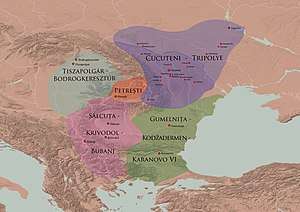
| Cucuteni–Trypillia culture (c. 4800 to 3000 BC) |
|---|
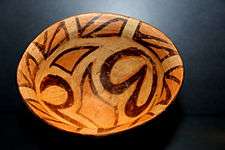 Characteristic example of Cucuteni–Trypillia pottery |
| Topics |
| Related articles |
|
Yamna culture → |
| Chalcolithic Eneolithic, Aeneolithic, or Copper Age |
|---|
|
↑ Stone Age ↑ Neolithic |
|
West Asia
|
|
Metallurgy, Wheel, Domestication of the horse |
|
↓ Bronze Age ↓ Iron Age |
It extended from the Carpathian Mountains to the Dniester and Dnieper regions, centred on modern-day Moldova and covering substantial parts of western Ukraine and northeastern Romania, encompassing an area of 350,000 km2 (140,000 sq mi), with a diameter of 500 km (300 mi; roughly from Kyiv in the northeast to Brașov in the southwest).[1][2]
The majority of Cucuteni–Trypillia settlements consisted of high-density, small settlements (spaced 3 to 4 kilometres apart), concentrated mainly in the Siret, Prut and Dniester river valleys.[3]
During the Middle Trypillia phase (c. 4000 to 3500 BCE), populations belonging to the Cucuteni–Trypillia culture built the largest settlements in Neolithic Europe, some of which contained as many as three thousand structures and were possibly inhabited by 20,000 to 46,000 people.[4][5][6]
One of the most notable aspects of this culture was the periodic destruction of settlements, with each single-habitation site having a lifetime of roughly 60 to 80 years.[7] The purpose of burning these settlements is a subject of debate among scholars; some of the settlements were reconstructed several times on top of earlier habitational levels, preserving the shape and the orientation of the older buildings. One particular location; the Poduri site in Romania, revealed thirteen habitation levels that were constructed on top of each other over many years.[7]
Nomenclature
The culture was initially named after the village of Cucuteni in Iași County, Romania. In 1884, Teodor T. Burada, after having seen ceramic fragments in the gravel used to maintain the road from Târgu Frumos to Iași, investigated the quarry in Cucuteni from where the material was mined, where he found fragments of pottery and terracotta figurines. Burada and other scholars from Iași, including the poet Nicolae Beldiceanu and archeologists Grigore Butureanu, Dimitrie C. Butculescu and George Diamandy, subsequently began the first excavations at Cucuteni in the spring of 1885.[8] Their findings were published in 1885[9] and 1889,[10] and presented in two international conferences in 1889, both in Paris: at the International Union for Prehistoric and Protohistoric Sciences by Butureanu[8] and at a meeting of the Society of Anthropology of Paris by Diamandi.[11]
At the same time, the first Ukrainian sites ascribed to the culture were discovered by Vikentiy Khvoyka, a Czech-born Ukrainian archeologist, in Kyiv at Kyrylivska street 55. The year of his discoveries has been variously claimed as 1893,[12] 1896[13] and 1887.[14] Subsequently, Chvojka presented his findings at the 11th Congress of Archaeologists in 1897, which is considered the official date of the discovery of the Trypillia culture in Ukraine.[12][14] In the same year, similar artifacts were excavated in the village of Trypillia (Ukrainian: Трипiлля), in Kyiv Oblast, Ukraine. As a result, this culture became identified in Ukrainian publications (and later in Soviet Russia), as the 'Tripolie' (or 'Tripolye', from Russian Триполье), 'Tripolian' or 'Trypillia' culture.
Today, the finds from both Romania and Ukraine, as well as those from Moldova, are recognised as belonging to the same cultural complex. It is generally called the Cucuteni culture in Romania and the Trypillia culture in Ukraine. In English, "Cucuteni–Tripolye culture" is most commonly used to refer to the whole culture,[15] with the Ukrainian-derived term "Cucuteni–Trypillia culture" gaining currency following the dissolution of the Soviet Union.
Geography
The Cucuteni–Trypillia culture flourished in the territory of what is now Moldova, northeastern Romania and parts of Western, Central and Southern Ukraine.
The culture thus extended northeast from the Danube river basin around the Iron Gates to the Black Sea and the Dnieper. It encompassed the central Carpathian Mountains as well as the plains, steppe and forest steppe on either side of the range. Its historical core lay around the middle to upper Dniester (the Podolian Upland).[2] During the Atlantic and Subboreal climatic periods in which the culture flourished, Europe was at its warmest and moistest since the end of the last Ice Age, creating favorable conditions for agriculture in this region.
As of 2003, about 3,000 cultural sites have been identified,[7] ranging from small villages to "vast settlements consisting of hundreds of dwellings surrounded by multiple ditches".[16]
Chronology
Periodisation
Traditionally separate schemes of periodisation have been used for the Ukrainian Trypillia and Romanian Cucuteni variants of the culture. The Cucuteni scheme, proposed by the German archaeologist Hubert Schmidt in 1932,[17] distinguished three cultures: Pre-Cucuteni, Cucuteni and Horodiştea–Folteşti; which were further divided into phases (Pre-Cucuteni I–III and Cucuteni A and B).[18] The Ukrainian scheme was first developed by Tatiana Sergeyevna Passek in 1949[19] and divided the Trypillia culture into three main phases (A, B and C) with further sub-phases (BI–II and CI–II).[18] Initially based on informal ceramic seriation, both schemes have been extended and revised since first proposed, incorporating new data and formalised mathematical techniques for artifact seriation.[20](p103)
The Cucuteni–Trypillia culture is commonly divided into an Early, Middle, Late period, with varying smaller sub-divisions marked by changes in settlement and material culture. A key point of contention lies in how these phases correspond to radiocarbon data. The following chart represents this most current interpretation:[18]
| • Early (Pre-Cucuteni I–III to Cucuteni A–B, Trypillia A to Trypillia BI–II): | 5800 to 5000 BC |
| • Middle (Cucuteni B, Trypillia BII to CI–II): | 5000 to 3500 BC |
| • Late (Horodiştea–Folteşti, Trypillia CII): | 3500 to 3000 BC |
Early period (5800–5000 BCE)
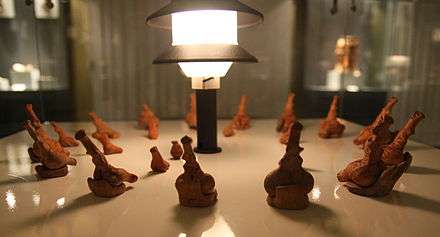
The roots of Cucuteni–Trypillia culture can be found in the Starčevo–Körös–Criș and Vinča cultures of the 6th to 5th millennia,[7] with additional influence from the Bug–Dniester culture (6500–5000 BC).[21] During the early period of its existence (in the fifth millennium BCE), the Cucuteni–Trypillia culture was also influenced by the Linear Pottery culture from the north, and by the Boian culture from the south.[7] Through colonisation and acculturation from these other cultures, the formative Pre-Cucuteni/Trypillia A culture was established. Over the course of the fifth millennium, the Cucuteni–Trypillia culture expanded from its 'homeland' in the Prut–Siret region along the eastern foothills of the Carpathian Mountains into the basins and plains of the Dnieper and Southern Bug rivers of central Ukraine.[22] Settlements also developed in the southeastern stretches of the Carpathian Mountains, with the materials known locally as the Ariuşd culture (see also: Prehistory of Transylvania). Most of the settlements were located close to rivers, with fewer settlements located on the plateaus. Most early dwellings took the form of pit-houses, though they were accompanied by an ever-increasing incidence of above-ground clay houses.[22] The floors and hearths of these structures were made of clay, and the walls of clay-plastered wood or reeds. Roofing was made of thatched straw or reeds.
The inhabitants were involved with animal husbandry, agriculture, fishing and gathering. Wheat, rye and peas were grown. Tools included ploughs made of antler, stone, bone and sharpened sticks. The harvest was collected with scythes made of flint-inlaid blades. The grain was milled into flour by quern-stones. Women were involved in pottery, textile- and garment-making, and played a leading role in community life. Men hunted, herded the livestock, made tools from flint, bone and stone. Of their livestock, cattle were the most important, with swine, sheep and goats playing lesser roles. The question of whether or not the horse was domesticated during this time of the Cucuteni–Trypillia culture is disputed among historians; horse remains have been found in some of their settlements, but it is unclear whether these remains were from wild horses or domesticated ones.
Clay statues of females and amulets have been found dating to this period. Copper items, primarily bracelets, rings and hooks, are occasionally found as well. A hoard of a large number of copper items was discovered in the village of Cărbuna, Moldova, consisting primarily of items of jewelry, which were dated back to the beginning of the fifth millennium BCE. Some historians have used this evidence to support the theory that a social stratification was present in early Cucuteni culture, but this is disputed by others.[7]
Pottery remains from this early period are very rarely discovered; the remains that have been found indicate that the ceramics were used after being fired in a kiln. The outer colour of the pottery is a smoky grey, with raised and sunken relief decorations. Toward the end of this early Cucuteni–Trypillia period, the pottery begins to be painted before firing. The white-painting technique found on some of the pottery from this period was imported from the earlier and contemporary (5th millennium) Gumelnița–Karanovo culture. Historians point to this transition to kiln-fired, white-painted pottery as the turning point for when the Pre-Cucuteni culture ended and Cucuteni Phase (or Cucuteni–Trypillia culture) began.[7]
Cucuteni and the neighbouring Gumelniţa–Karanovo cultures seem to be largely contemporary; the "Cucuteni A phase seems to be very long (4600–4050) and covers the entire evolution of the Gumelnița–Karanovo A1, A2, B2 phases (maybe 4650–4050)."[23]
Middle period (4000–3500 BC)
In the middle era, the Cucuteni–Trypillia culture spread over a wide area from Eastern Transylvania in the west to the Dnieper River in the east. During this period, the population immigrated into and settled along the banks of the upper and middle regions of the Right Bank (or western side) of the Dnieper River, in present-day Ukraine. The population grew considerably during this time, resulting in settlements being established on plateaus, near major rivers and springs.
Their dwellings were built by placing vertical poles in the form of circles or ovals. The construction techniques incorporated log floors covered in clay, wattle-and-daub walls that were woven from pliable branches and covered in clay and a clay oven, which was situated in the centre of the dwelling. As the population in this area grew, more land was put under cultivation. Hunting supplemented the practice of animal husbandry of domestic livestock.
Tools made of flint, rock, clay, wood and bones continued to be used for cultivation and other chores. Much less common than other materials, copper axes and other tools have been discovered that were made from ore mined in Volyn, Ukraine, as well as some deposits along the Dnieper river. Pottery-making by this time had become sophisticated, however they still relied on techniques of making pottery by hand (the potter's wheel was not used yet). Characteristics of the Cucuteni–Trypillia pottery included a monochromic spiral design, painted with black paint on a yellow and red base. Large pear-shaped pottery for the storage of grain, dining plates and other goods, was also prevalent. Additionally, ceramic statues of female "goddess" figures, as well as figurines of animals and models of houses dating to this period have also been discovered.
Some scholars have used the abundance of these clay female fetish statues to base the theory that this culture was matriarchal in nature. Indeed, it was partially the archaeological evidence from Cucuteni–Trypillia culture that inspired Marija Gimbutas, Joseph Campbell and some latter 20th century feminists to set forth the popular theory of an Old European culture of peaceful, egalitarian (counter to a widespread misconception, not matriarchal[24]), goddess-centred neolithic European societies that were wiped out by patriarchal, Sky Father-worshipping, warlike, Bronze-Age Proto-Indo-European tribes that swept out of the steppes north and east of the Black Sea.
Late period (3500–3000 BC)
During the late period, the Cucuteni–Trypillia territory expanded to include the Volyn region in northwest Ukraine, the Sluch and Horyn Rivers in northern Ukraine and along both banks of the Dnieper river near Kyiv. Members of the Cucuteni–Trypillia culture who lived along the coastal regions near the Black Sea came into contact with other cultures. Animal husbandry increased in importance, as hunting diminished; horses also became more important. The community transformed into a patriarchal structure. Outlying communities were established on the Don and Volga rivers in present-day Russia. Dwellings were constructed differently from previous periods, and a new rope-like design replaced the older spiral-patterned designs on the pottery. Different forms of ritual burial were developed where the deceased were interred in the ground with elaborate burial rituals. An increasingly larger number of Bronze Age artefacts originating from other lands were found as the end of the Cucuteni–Trypillia culture drew near.[7]
Decline and end
There is a debate among scholars regarding how the end of the Cucuteni–Trypillia culture took place.
According to some proponents of the Kurgan hypothesis of the origin of Proto-Indo-Europeans, and in particular the archaeologist Marija Gimbutas, in her book "Notes on the chronology and expansion of the Pit-Grave Culture" (1961, later expanded by her and others), the Cucuteni–Trypillia culture was destroyed by force. Arguing from archaeological and linguistic evidence, Gimbutas concluded that the people of the Kurgan culture (a term grouping the Yamnaya culture and its predecessors) of the Pontic–Caspian steppe, being most likely speakers of the Proto-Indo-European language, effectively destroyed the Cucuteni–Trypillia culture in a series of invasions undertaken during their expansion to the west. Based on this archaeological evidence Gimbutas saw distinct cultural differences between the patriarchal, warlike Kurgan culture and the more peaceful egalitarian Cucuteni–Trypillia culture, which she argued was a significant component of the "Old European cultures" which finally met extinction in a process visible in the progressing appearance of fortified settlements, hillforts and the graves of warrior-chieftains, as well as in the religious transformation from the matriarchy to patriarchy, in a correlated east–west movement.[25] In this, "the process of Indo-Europeanization was a cultural, not a physical, transformation and must be understood as a military victory in terms of successfully imposing a new administrative system, language, and religion upon the indigenous groups.[26] Accordingly, these proponents of the Kurgan hypothesis hold that this invasion took place during the third wave of Kurgan expansion between 3000–2800 BC, permanently ending the Cucuteni–Trypillia culture.
In his 1989 book In Search of the Indo-Europeans, Irish-American archaeologist J. P. Mallory, summarising the three existing theories concerning the end of the Cucuteni–Trypillia culture, mentions that archaeological findings in the region indicate Kurgan (i.e. Yamnaya culture) settlements in the eastern part of the Cucuteni–Trypillia area, co-existing for some time with those of the Cucuteni–Trypillia.[3] Artifacts from both cultures found within each of their respective archaeological settlement sites attest to an open trade in goods for a period,[3] though he points out that the archaeological evidence clearly points to what he termed "a dark age," its population seeking refuge in every direction except east. He cites evidence of the refugees having used caves, islands and hilltops (abandoning in the process 600–700 settlements) to argue for the possibility of a gradual transformation rather than an armed onslaught bringing about cultural extinction.[3] The obvious issue with that theory is the limited common historical life-time between the Cucuteni–Trypillia (4800–3000 BC) and the Yamnaya culture (3300–2600 BC); given that the earliest archaeological findings of the Yamnaya culture are located in the Volga–Don basin, not in the Dniester and Dnieper area where the cultures came in touch, while the Yamnaya culture came to its full extension in the Pontic steppe at the earliest around 3000 BC, the time the Cucuteni–Trypillia culture ended, thus indicating an extremely short survival after coming in contact with the Yamnaya culture. Another contradicting indication is that the kurgans that replaced the traditional horizontal graves in the area now contain human remains of a fairly diversified skeletal type approximately ten centimetres taller on average than the previous population.[3]
In the 1990s and 2000s, another theory regarding the end of the Cucuteni–Trypillia culture emerged based on climatic change that took place at the end of their culture's existence that is known as the Blytt–Sernander Sub-Boreal phase. Beginning around 3200 BC, the earth's climate became colder and drier than it had ever been since the end of the last Ice age, resulting in the worst drought in the history of Europe since the beginning of agriculture.[27] The Cucuteni–Trypillia culture relied primarily on farming, which would have collapsed under these climatic conditions in a scenario similar to the Dust Bowl of the American Midwest in the 1930s.[28] According to The American Geographical Union,
The transition to today's arid climate was not gradual, but occurred in two specific episodes. The first, which was less severe, occurred between 6,700 and 5,500 years ago. The second, which was brutal, lasted from 4,000 to 3,600 years ago. Summer temperatures increased sharply, and precipitation decreased, according to carbon-14 dating. According to that theory, the neighboring Yamnaya culture people were pastoralists, and were able to maintain their survival much more effectively in drought conditions. This has led some scholars to come to the conclusion that the Cucuteni–Trypillia culture ended not violently, but as a matter of survival, converting their economy from agriculture to pastoralism, and becoming integrated into the Yamnaya culture.[21][27][28][29]
However, the Blytt–Sernander approach as a way to identify stages of technology in Europe with specific climate periods is an oversimplification not generally accepted. A conflict with that theoretical possibility is that during the warm Atlantic period, Denmark was occupied by Mesolithic cultures, rather than Neolithic, notwithstanding the climatic evidence. Moreover, the technology stages varied widely globally. To this must be added that the first period of the climate transformation ended 500 years before the end of the Cucuteni–Trypillia culture and the second approximately 1400 years after.
Economy
Throughout the 2,750 years of its existence, the Cucuteni–Trypillia culture was fairly stable and static; however, there were changes that took place. This article addresses some of these changes that have to do with the economic aspects. These include the basic economic conditions of the culture, the development of trade, interaction with other cultures and the apparent use of barter tokens, an early form of money.
Members of the Cucuteni–Trypillia culture shared common features with other Neolithic societies, including:
- An almost nonexistent social stratification
- Lack of a political elite
- Rudimentary economy, most likely a subsistence or gift economy
- Pastoralists and subsistence farmers
Earlier societies of hunter-gatherer tribes had no social stratification, and later societies of the Bronze Age had noticeable social stratification, which saw the creation of occupational specialization, the state and social classes of individuals who were of the elite ruling or religious classes, full-time warriors and wealthy merchants, contrasted with those individuals on the other end of the economic spectrum who were poor, enslaved and hungry. In between these two economic models (the hunter-gatherer tribes and Bronze Age civilisations) we find the later Neolithic and Eneolithic societies such as the Cucuteni–Trypillia culture, where the first indications of social stratification began to be found. However, it would be a mistake to overemphasise the impact of social stratification in the Cucuteni–Trypillia culture, since it was still (even in its later phases) very much an egalitarian society. And of course, social stratification was just one of the many aspects of what is regarded as a fully established civilised society, which began to appear in the Bronze Age.[21]
Like other Neolithic societies, the Cucuteni–Trypillia culture had almost no division of labor. Although this culture's settlements sometimes grew to become the largest on Earth at the time (up to 15,000 people in the largest),[30] there is no evidence that has been discovered of labour specialisation. Every household probably had members of the extended family who would work in the fields to raise crops, go to the woods to hunt game and bring back firewood, work by the river to bring back clay or fish and all of the other duties that would be needed to survive. Contrary to popular belief, the Neolithic people experienced considerable abundance of food and other resources.[2]
Since every household was almost entirely self-sufficient, there was very little need for trade. However, there were certain mineral resources that, because of limitations due to distance and prevalence, did form the rudimentary foundation for a trade network that towards the end of the culture began to develop into a more complex system, as is attested to by an increasing number of artifacts from other cultures that have been dated to the latter period.[3]
Toward the end of the Cucuteni–Trypillia culture's existence (from roughly 3000 BC to 2750 BC), copper traded from other societies (notably, from the Balkans) began to appear throughout the region, and members of the Cucuteni–Trypillia culture began to acquire skills necessary to use it to create various items. Along with the raw copper ore, finished copper tools, hunting weapons and other artefacts were also brought in from other cultures.[2] This marked the transition from the Neolithic to the Eneolithic, also known as the Chalcolithic or Copper Age. Bronze artifacts began to show up in archaeological sites toward the very end of the culture. The primitive trade network of this society, that had been slowly growing more complex, was supplanted by the more complex trade network of the Proto-Indo-European culture that eventually replaced the Cucuteni–Trypillia culture.[2]
- Copper tools
- Around 4000 BC this treasure was buried on a Dniester river terrace
- Cucuteni Spoon
- Clay bird figurines
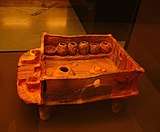
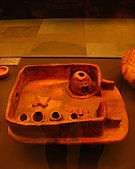
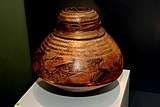
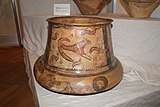
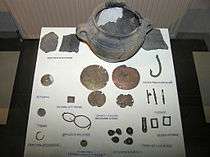 Bronze artifacts, later period
Bronze artifacts, later period- Model of a pottery kiln

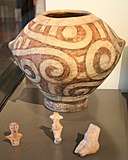
Diet
The Cucuteni–Trypillia culture was a society of subsistence farmers. Cultivating the soil (using an ard or scratch plough), harvesting crops and tending livestock was probably the main occupation for most people. Typically for a Neolithic culture, the vast majority of their diet consisted of cereal grains. They cultivated club wheat, oats, rye, proso millet, barley and hemp, which were probably ground and baked as unleavened bread in clay ovens or on heated stones in the home. They also grew peas and beans, apricot, cherry plum and wine grapes – though there is no solid evidence that they actually made wine.[31] There is also evidence that they may have kept bees.[32]
The zooarchaeology of Cucuteni–Trypillia sites indicate that the inhabitants practiced animal husbandry. Their domesticated livestock consisted primarily of cattle, but included smaller numbers of pigs, sheep and goats. There is evidence, based on some of the surviving artistic depictions of animals from Cucuteni–Trypillia sites, that the ox was employed as a draft animal.[31]
Both remains and artistic depictions of horses have been discovered at Cucuteni–Trypillia sites. However, whether these finds are of domesticated or wild horses is debated. Before they were domesticated, humans hunted wild horses for meat. On the other hand, one hypothesis of horse domestication places it in the steppe region adjacent to the Cucuteni–Trypillia culture at roughly the same time (4000–3500 BC), so it is possible the culture was familiar with the domestic horse. At this time horses could have been kept both for meat or as a work animal.[33] The direct evidence remains inconclusive.[34]
Hunting supplemented the Cucuteni–Trypillia diet. They used traps to catch their prey, as well as various weapons, including the bow and arrow, the spear and clubs. To help them in stalking game, they sometimes disguised themselves with camouflage.[33] Remains of game species found at Cucuteni–Trypillia sites include red deer, roe deer, aurochs, wild boar, fox and brown bear.
Salt
The earliest known salt works in the world is at Poiana Slatinei, near the village of Lunca in Vânători-Neamț, Romania. It was first used in the early Neolithic, around 6050 BC, by the Starčevo culture, and later by the Cucuteni–Trypillia culture in the Pre-Cucuteni period.[35] Evidence from this and other sites indicates that the Cucuteni–Trypillia culture extracted salt from salt-laden spring-water through the process of briquetage. First, the brackish water from the spring was boiled in large pottery vessels, producing a dense brine. The brine was then heated in a ceramic briquetage vessel until all moisture was evaporated, with the remaining crystallised salt adhering to the inside walls of the vessel. Then the briquetage vessel was broken open, and the salt was scraped from the shards.[36]
The provision of salt was a major logistical problem for the largest Cucuteni–Trypillia settlements. As they came to rely upon cereal foods over salty meat and fish, Neolithic cultures had to incorporate supplementary sources of salt into their diet. Similarly, domestic cattle need to be provided with extra sources of salt beyond their normal diet or their milk production is reduced. Cucuteni–Trypillia mega-sites, with a population of likely thousands of people and animals, are estimated to have required between 36,000 and 100,000 kg of salt per year. This was not available locally, and so had to be moved in bulk from distant sources on the western Black Sea coast and in the Carpathian Mountains, probably by river.[37]
Technology and material culture
The Cucuteni–Trypillia culture is known by its distinctive settlements, architecture, intricately decorated pottery and anthropomorphic and zoomorphic figurines, which are preserved in archaeological remains. At its peak it was one of the most technologically advanced societies in the world at the time,[3] developing new techniques for ceramic production, housing building, agriculture and producing woven textiles (although these have not survived and are known indirectly).
Settlements
.jpg)
In terms of overall size, some of Cucuteni–Trypillia sites, such as Talianki (with a population of 15,000 and covering an area of 335[38] hectares) in the province of Uman Raion, Ukraine, are as large as (or perhaps even larger than) the city-states of Sumer in the Fertile Crescent, and these Eastern European settlements predate the Sumerian cities by more than half of a millennium.[39]
Archaeologists have uncovered a large number of artefacts from these ancient ruins. The largest collections of Cucuteni–Trypillia artefacts are to be found in museums in Russia, Ukraine and Romania, including the Hermitage Museum in St. Petersburg and the Archaeology Museum Piatra Neamţ in Romania. However, smaller collections of artefacts are kept in many local museums scattered throughout the region.[21]
These settlements underwent periodical acts of destruction and re-creation, as they were burned and then rebuilt every 60–80 years. Some scholars have theorised that the inhabitants of these settlements believed that every house symbolised an organic, almost living, entity. Each house, including its ceramic vases, ovens, figurines and innumerable objects made of perishable materials, shared the same circle of life, and all of the buildings in the settlement were physically linked together as a larger symbolic entity. As with living beings, the settlements may have been seen as also having a life cycle of death and rebirth.[40]
The houses of the Cucuteni–Trypillia settlements were constructed in several general ways:
- Wattle-and-daub homes.
- Log homes, called (Ukrainian: площадки, romanized: ploshchadky).
- Semi-underground homes called bordei.
Some Cucuteni–Trypillia homes were two storeys tall, and evidence shows that the members of this culture sometimes decorated the outsides of their homes with many of the same red-ochre complex swirling designs that are to be found on their pottery. Most houses had thatched roofs and wooden floors covered with clay.[39]
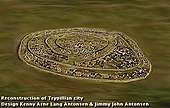 Reconstruction of a Trypillia city
Reconstruction of a Trypillia city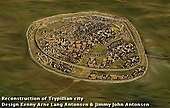 Reconstruction of a Trypillia city
Reconstruction of a Trypillia city.jpg) Reconstruction of Maydanets c. 4000 BC, Trypillan city
Reconstruction of Maydanets c. 4000 BC, Trypillan city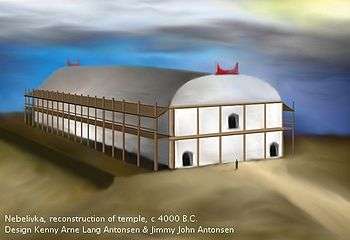 Reconstruction of a temple from Nebelivka, Ukraine, c. 4000 BC, 60 × 20 m size
Reconstruction of a temple from Nebelivka, Ukraine, c. 4000 BC, 60 × 20 m size- House interior reconstruction
- Top view of Cucuteni house model
- Village model
 Illustration of interconnected houses from Maidanetsk
Illustration of interconnected houses from Maidanetsk
Pottery
Most Cucuteni–Trypillia pottery was hand coiled from local clay. Long coils of clay were placed in circles to form first the base and then the walls of the vessel. Once the desired shape and height of the finished product was built up the sides would then be smoothed to create a seamless surface. This technique was the earliest form of pottery shaping and the most common in the Neolithic; however, there is some evidence that they also used a primitive type of slow-turning potter's wheel, an innovation that did not become common in Europe until the Iron Age.[33]
Characteristically vessels were elaborately decorated with swirling patterns and intricate designs. Sometimes decorative incisions were added prior to firing, and sometimes these were filled with coloured dye to produce a dimensional effect. In the early period, the colours used to decorate pottery were limited to a rusty-red and white. Later, potters added additional colours to their products and experimented with more advanced ceramic techniques.[7] The pigments used to decorate ceramics were based on iron oxide for red hues, calcium carbonate, iron magnetite and manganese Jacobsite ores for black and calcium silicate for white. The black pigment, which was introduced during the later period of the culture, was a rare commodity: taken from a few sources and circulated (to a limited degree) throughout the region. The probable sources of these pigments were Iacobeni in Romania for the iron magnetite ore and Nikopol in Ukraine for the manganese Jacobsite ore.[41][42] No traces of the iron magnetite pigment mined in the easternmost limit of the Cucuteni–Trypillia region have been found to be used in ceramics from the western settlements, suggesting exchange throughout the entire cultural area was limited. In addition to mineral sources, pigments derived from organic materials (including bone and wood) were used to create various colours.[43]
In the late period of Cucuteni–Trypillia culture, kilns with a controlled atmosphere were used for pottery production. These kilns were constructed with two separate chambers—the combustion chamber and the filling chamber— separated by a grate. Temperatures in the combustion chamber could reach 1000–1100 °C but were usually maintained at around 900 °C to achieve a uniform and complete firing of vessels.[41]
Toward the end of the Cucuteni–Trypillia culture, as copper became more readily available, advances in ceramic technology levelled off as more emphasis was placed on developing metallurgical techniques.
Ceramic figurines
An anthropomorphic ceramic artefact was discovered during an archaeological dig in 1942 on Cetatuia Hill near Bodeşti, Neamţ County, Romania, which became known as the "Cucuteni Frumusica Dance" (after a nearby village of the same name). It was used as a support or stand, and upon its discovery was hailed as a symbolic masterpiece of Cucuteni–Trypillia culture. It is believed that the four stylised feminine silhouettes facing inward in an interlinked circle represented a hora, or ritualistic dance. Similar artefacts were later found in Bereşti and Drăgușeni.
Extant figurines excavated at the Cucuteni sites are thought to represent religious artifacts, but their meaning or use is still unknown. Some historians as Gimbutas claim that:
...the stiff nude to be representative of death on the basis that the color white is associated with the bone (that which shows after death). Stiff nudes can be found in Hamangia, Karanovo, and Cucuteni cultures[44]
Textiles
No examples of Cucuteni–Trypillia textiles have yet been found – preservation of prehistoric textiles is rare and the region does not have a suitable climate. However, impressions of textiles are found on pottery sherds (because the clay was placed there before it was fired). These show that woven fabrics were common in Cucuteni–Trypillia society.[45][46] Finds of ceramic weights with drilled holes suggest that these were manufactured with a warp-weighted loom.[47] It has also been suggested that these weights, especially "disposable" examples made from poor quality clay and inadequately fired, were used to weigh down fishing nets. These would probably have been frequently lost, explaining their inferior quality.[48]
Other pottery sherds with textile impressions, found at Frumuşica and Cucuteni, suggest that textiles were also knitted (specifically using a technique known as nalbinding).[49]
Weapons and tools
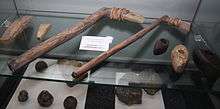
Cucuteni–Trypillia tools were made from knapped and polished stone, organic materials (bone, antler and horn), and in the later period, copper. Local Miorcani flint was the most common material for stone tools, but a number of other types are known to have been used, including chert, jasper and obsidian. Presumably these tools were hafted with wood, but this is not preserved. Weapons are rare but not unknown, implying the culture was relatively peaceful.[50]
The following types of tools have been discovered at Cucuteni–Trypillia sites:
| Tool | Typical materials | |
|---|---|---|
| Woodworking | Adzes | Stone, flint, copper |
| Burins | ||
| Scrapers | ||
| Awls | Stone, antler, horn, copper | |
| Gouges/chisels | Stone, bone | |
| Lithic reduction | Pressure flaking tools, e.g. abrasive pieces, plungers, pressing and retouching tools |
Stone |
| Anvils | ||
| Hammerstones | ||
| Soft hammers | Antler, horn | |
| Polishing tools | Bone, stone | |
| Textiles | Knitting needles | Bone |
| Shuttles | ||
| Sewing needles | Bone, copper | |
| Spindles and spindle whorls | Clay | |
| Loom weights | ||
| Farming | Hoes | Antler, horn |
| Ards | ||
| Ground stones/metates and grinding slabs | Stone | |
| Scythes | Flint pieces inlaid into antler or wood blades | |
| Fishing | Harpoons | Bone |
| Fish hooks | Bone, copper | |
| Other/multipurpose | Axes, including double-headed axes, hammer axes and possible battle axes |
Stone, copper |
| Clubs | Stone | |
| Knives and daggers | Flint, bone, copper | |
| Arrow tips | Flint, bone | |
| Handles | ||
| Spatulas | ||
Wheels
Some researchers, e.g., Asko Parpola, an Indologist at the University of Helsinki in Finland, believe that the CT-culture used the wheel with wagons. However, only miniature models of animals and cups on 4 wheels have been found, and they date to the first half of the fourth millennium BC.[51] Such models are often thought to have been children's toys; nevertheless, they do convey the idea that objects could be pulled on wheels. Up to now there is no evidence for wheels used with real wagons.
Ritual and religion
Some Cucuteni–Trypillia communities have been found that contain a special building located in the centre of the settlement, which archaeologists have identified as sacred sanctuaries. Artefacts have been found inside these sanctuaries, some of them having been intentionally buried in the ground within the structure, that are clearly of a religious nature, and have provided insights into some of the beliefs, and perhaps some of the rituals and structure, of the members of this society. Additionally, artefacts of an apparent religious nature have also been found within many domestic Cucuteni–Trypillia homes.
Many of these artefacts are clay figurines or statues. Archaeologists have identified many of these as fetishes or totems, which are believed to be imbued with powers that can help and protect the people who look after them.[20] These Cucuteni–Trypillia figurines have become known popularly as goddesses; however, this term is not necessarily accurate for all female anthropomorphic clay figurines, as the archaeological evidence suggests that different figurines were used for different purposes (such as for protection), and so are not all representative of a goddess.[20] There have been so many of these figurines discovered in Cucuteni–Trypillia sites[20] that many museums in eastern Europe have a sizeable collection of them, and as a result, they have come to represent one of the more readily identifiable visual markers of this culture to many people.
The archaeologist Marija Gimbutas based at least part of her Kurgan Hypothesis and Old European culture theories on these Cucuteni–Trypillia clay figurines. Her conclusions, which were always controversial, today are discredited by many scholars,[20] but still there are some scholars who support her theories about how neolithic societies were matriarchal, non-warlike, and worshipped an "earthy" mother goddess, but were subsequently wiped out by invasions of patriarchal Indo-European tribes who burst out of the steppes of Russia and Kazakhstan beginning around 2500 BC, and who worshipped a warlike Sky God.[44] However, Gimbutas' theories have been partially discredited by more recent discoveries and analyses.[3] Today there are many scholars who disagree with Gimbutas, pointing to new evidence that suggests a much more complex society during the Neolithic era than she had been accounting for.[52]
One of the unanswered questions regarding the Cucuteni–Trypillia culture is the small number of artefacts associated with funerary rites. Although very large settlements have been explored by archaeologists, the evidence for mortuary activity is almost invisible. Making a distinction between the eastern Trypillia and the western Cucuteni regions of the Cucuteni–Trypillia geographical area, American archaeologist Douglass W. Bailey writes:
There are no Cucuteni cemeteries and the Trypillia ones that have been discovered are very late.[20](p115)
The discovery of skulls is more frequent than other parts of the body, however because there has not yet been a comprehensive statistical survey done of all of the skeletal remains discovered at Cucuteni–Trypillia sites, precise post excavation analysis of these discoveries cannot be accurately determined at this time. Still, many questions remain concerning these issues, as well as why there seems to have been no male remains found at all.[53] The only definite conclusion that can be drawn from archaeological evidence is that in the Cucuteni–Trypillia culture, in the vast majority of cases, the bodies were not formally deposited within the settlement area.[20](p116)
Vinča–Turdaș script
The mainstream academic theory is that writing first appeared during the Sumerian civilisation in southern Mesopotamia, around 3300–3200 BC. in the form of the Cuneiform script. This first writing system did not suddenly appear out of nowhere, but gradually developed from less stylised pictographic systems that used ideographic and mnemonic symbols that contained meaning, but did not have the linguistic flexibility of the natural language writing system that the Sumerians first conceived. These earlier symbolic systems have been labelled as proto-writing, examples of which have been discovered in a variety of places around the world, some dating back to the 7th millennium BC.[54]
- One of the three Tărtăria tablets, dated 5300 BC
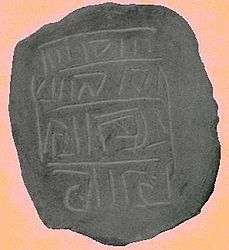 One of the Gradeshnitsa tablets
One of the Gradeshnitsa tablets
One such early example of a proto-writing system are the Vinča symbols, which is a set of symbols depicted on clay artefacts associated with the Vinča culture, which flourished along the Danube River in the Pannonian Plain, between 6000 and 4000 BC. The first discovery of this script occurred at the archaeological site in the village of Turdaş (Romania), and consisted of a collection of artefacts that had what appeared to be an unknown system of writing. In 1908, more of these same kinds of artefacts were discovered at a site near Vinča, outside the city of Belgrade, Serbia. Scholars subsequently labelled this the "Vinča script" or "Vinča–Turdaş script". There is a considerable amount of controversy surrounding the Vinča script as to how old it is, as well as whether it should be considered as an actual writing system, an example of proto-writing, or just a collection of meaningful symbols. Indeed, the entire subject regarding every aspect of the Vinča script is fraught with controversy.[54]
Beginning in 1875 up to the present, archaeologists have found more than a thousand Neolithic era clay artefacts that have examples of symbols similar to the Vinča script scattered widely throughout south-eastern Europe. This includes the discoveries of what appear to be barter tokens, which were used as an early form of currency. Thus it appears that the Vinča or Vinča–Turdaş script is not restricted to just the region around Belgrade, which is where the Vinča culture existed, but that it was spread across most of southeastern Europe, and was used throughout the geographical region of the Cucuteni–Trypillia culture. As a result of this widespread use of this set of symbolic representations, historian Marco Merlini has suggested that it be given a name other than the Vinča script, since this implies that it was only used among the Vinča culture around the Pannonian Plain, at the very western edge of the extensive area where examples of this symbolic system have been discovered. Merlini has proposed naming this system the Danube Script, which some scholars have begun to accept.[55] However, even this name change would not be extensive enough, since it does not cover the region in Ukraine, as well as the Balkans, where examples of these symbols are also found. Whatever name is used, however (Vinča script, Vinča–Turdaș script, Vinča symbols, Danube script, or Old European script), it is likely that it is the same system.[55]
Archaeogenetics
Nikitin (2011) analyzed mtDNA recovered from Cucuteni–Trypillia human osteological remains found in the Verteba Cave (on the bank of the Seret River, Ternopil Oblast, Ukraine). It revealed that seven of the individuals whose remains where analysed belonged to: two to haplogroup HV(xH), two to haplogroup H, one to haplogroup R0(xHV), one to haplogroup J and one to haplogroup T4, the latter also being the oldest sample of the set.
The authors conclude that the population living around Verteba Cave was fairly heterogenous, but that the wide chronological age of the specimens might indicate that the heterogeneity might have been due to natural population flow during this timeframe. The authors also link the R0(xHV) and HV(xH) haplogroups with European Paleolithic populations, and consider the T4 and J haplogroups as hallmarks of Neolithic demic intrusions from the southeast (the north-pontic region) rather than from the west (i.e. the Linear Pottery culture).[56]
A 2017 ancient DNA study found evidence of genetic contact between the Cucuteni–Trypillia culture and steppe populations from the east from as early as 3600 BCE, well before the influx of steppe ancestry into Europe associated with the Yamnaya culture.[57]
A February 2018 study published in Nature included an analysis of three males from the Cucuteni–Trypillia culture. With respect to Y-DNA, two carried haplogroup G2a2b2a, while one carried G2a. With respect to mtDNA, the males carried H5a, T2b, and HV.[58]
See also
- Barter tokens of the Cucuteni–Trypillia culture
- Chalcolithic Europe
- Copper Age
- Old Europe
- Vinča culture
- Varna culture
- Dnieper–Donets culture
- History of Ukraine
- Khvalynsk culture
- Linear Pottery culture
- Nebelivka (archaeological site)
- Neolithic Europe
- Prehistoric Romania
- Prehistory of Southeastern Europe
- Proto-Indo-Europeans
- Samara culture
- Sredny Stog culture
- Yamnaya culture
Notes
- "7,000 years ago, Neolithic optical art flourished – Technology & science – Science – DiscoveryNews.com". NBC News. 2008-09-22. Archived from the original on 2015-12-24. Retrieved 2015-12-24.
- Mantu, Cornelia-Magda (2000). "Cucuteni–Tripolye cultural complex: relations and synchronisms with other contemporaneous cultures from the Black Sea area". Studia Antiqua et Archaeologica. Iași, Romania: Iași University. VII: 267. OCLC 228808567. Archived from the original on 2011-07-11.
- Mallory, James P (1989). In search of the Indo-Europeans: language, archaeology and myth. London: Thames and Hudson. ISBN 0-500-05052-X. OCLC 246601873.
- Diachenko, Aleksandr; Francesco Menotti (2012). "The gravity model: monitoring the formation and development of the Tripolye culture giant-settlements in Ukraine". Journal of Archaeological Science. 39 (8): 2810–2817. doi:10.1016/j.jas.2012.04.025.
- Müller, Johannes. "High precision Tripolye settlement plans, demographic estimations and settlement organization". academia.edu. Archived from the original on 13 January 2017. Retrieved 6 May 2018.
- Müller, Johannes; Rassmann, Knut; Videiko, Mykhailo (2016). Trypillia Mega-Sites and European Prehistory: 4100-3400 BCE. Taylor & Francis. p. 347. ISBN 978-1-317-24791-3.
- Monah, Dan (2005), "Religie si arta in cultura Cucuteni" [Religion and art in Cucuteni culture], in Dumitroaia, Gheorghe (ed.), Primul muzeu Cucuteni din Romania [The first Cucuteni museum for Romania], Bibliotheca memoriae antiquitatis XV (in Romanian), Piatra-Neamţ, Romania: Editura Foton, pp. 162–173, OCLC 319165024
- "Cucuteni-Trypillya: una grande civiltà dell'antica Europa" [Cucuteni–Trypillia: a great civilization of ancient Europe] (Press release) (in Italian). Sapienza – Università di Roma. 16 September – 31 October 2008. Archived from the original on 17 July 2011. Retrieved 21 November 2009.
- Beldiceanu, Nicolae (1885). "Antichităţile de la Cucuteni" [The Antiquities at Cucuteni]. Schiţă Arheologică (in Romanian). Iaşi.
- Butureanu, Grigore (1989). "Notita asupra sapaturilor si cercetarilor facute la Cucuteni" [Note on the Diggings and Research at Cucuteni]. Arhiva Societăţii ştiinţifice şi Literare Din Iaşi (in Romanian). I.
- "In search of time past". The Institute of archaeology in Iaşi. Archived from the original on 4 September 2011. Retrieved 21 November 2009.
- "Welcome to the Trypillian e-Museum". The Trypillian Civilization Society. Archived from the original on 2008-06-07. Retrieved 21 November 2009.
- Videiko, Mykhailo. "Trypillian Civilization in the prehistory of Europe". The Trypillian Civilization Society. Archived from the original on 2008-06-21. Retrieved 21 November 2009.
- Taranec, Natalie. "The Trypilska Kultura – The Spiritual Birthplace of Ukraine?". The Trypillian Civilization Society. Archived from the original on 2008-06-21. Retrieved 21 November 2009.
- Ellis, Linda (1984). The Cucuteni–Tripolye culture: study in technology and the origins of complex society. BAR international series. 217. Oxford: British Archaeological Reports (B.A.R). ISBN 0-86054-279-3. OCLC 11385722.
- Mallory, J.P.; Adams, D.Q. (1997), Encyclopedia of Indo-European Culture, Chicago: Fitzroy Dearborn, OCLC 37931209
- Schmidt, Hubert (1932), Cucuteni in der oberen Moldau, Rumănien: die befestigte Siedlung mit bemalter Keramik von der Steinkupferzeit bis in die vollentwickelte Bronzezeit [Cucuteni in upper Moldova, Romania: the fortified settlement with painted pottery from the stone age to the copper age] (in German), Berlin: W. de Gruyter, OCLC 4942033
- Lazarovici, Cornelia-Magda (2010). "New data regarding the chronology of the Pre-Cucuteni, Cucuteni and Horodiştea–Erbiceni cultures". PANTA RHEI: Studies on the Chronology and Cultural Development of South-Eastern and Central Europe in Earlier Prehistory Presented to Juraj Pavúk on the Occasion of His 75th Birthday: 71–94.
- Passek, Tatiana Sergeyevna (1949), Periodizatsiia tripolʹskikh poseleniĭ, iii–ii tysiacheletie do n. ė. [Trypillia settlement periodization…], Materialy i issledovaniia po arkheologii SSSR (in Russian), 10, Moscow: Izd-vo Akademii nauk SSSR, OCLC 27000780
- Bailey, Douglass W. (2005). Prehistoric figurines: representation and corporeality in the Neolithic. London; New York: Routledge. OCLC 56686499.
- Khol, Philip L. (2002). "Archeological transformations: crossing the pastoral/agricultural bridge". Iranica Antiqua. Leiden: E.J. Brill. 37: 151–190. OCLC 60616426. Archived from the original on 17 July 2011. Retrieved 21 November 2009.
- Zbenovich, Vladimir G. (1996-06-01). "The Tripolye culture: Centenary of research". Journal of World Prehistory. 10 (2): 199–241. doi:10.1007/BF02221076. ISSN 1573-7802.
- Cornelia-Magda Mantu (PDF file) Cucuteni–Tripolye Cultural Complex: Relations and Synchronisms with Other Contemporaneous Cultures from the Black Sea Area. Archived 2015-06-08 at the Wayback Machine Studia Antiqua et Archaeologica, VII, 2000
- "Interview with Marija Gimbutas". Archived from the original on 2016-10-07. Retrieved 2016-07-17.
- Gimbutas (1982:1)
- Gimbutas, Dexter & Jones-Bley (1997:309)
- Anthony, David W. (2007). The Horse, the Wheel, and Language: How Bronze Age Riders from the Eurasian Steppes Shaped the Modern World. Princeton, NJ: Princeton University Press. ISBN 978-0-691-05887-0.
- Todorova, Henrietta (1995). "The Neolithic, Eneolithic, and Transitional in Bulgarian Prehistory". in Bailey, Douglass W.; Panayotov, Ivan. Prehistoric Bulgaria. Monographs in World Archaeology. 22. Madison, WI: Prehistoric Press. pp. 79–98. ISBN 1-881094-11-1.
- DeMeo, James (1998). Saharasia: the 4000 BCE origins of child abuse, sex-repression, warfare and social violence in the deserts of the Old World: the revolutionary discovery of a geographic basis to human behavior. Greensprings, Oregon: Orgone Biophysical Research Lab. ISBN 0-9621855-5-8. OCLC 39569359.
- Chapman, John; Videiko, Mikhail Yu; Hale, Duncan; Gaydarska, Bisserka; Burdo, Natalia; Rassmann, Knut; Mischka, Carsten; Müller, Johannes; Korvin-Piotrovskiy, Aleksey (2014). "The Second Phase of the Trypillia Mega-Site Methodological Revolution: A New Research Agenda". European Journal of Archaeology. 17 (3): 369–406. doi:10.1179/1461957114Y.0000000062. ISSN 1461-9571.
- Comșa, Eugen (1973). "Cultura plantelor în cursul epocii neolitice pe teritoriul României" [Cultivated plants of the Neolithic current epoch in Romanian territory]. Terra Nostra: Culegere de Materiale Privind Istoria Agriculturii în România (Our Earth: Selections from a Material Perspective of Agricultural History in Romania). Bucharest: Consiliul Superior al Agriculturii. 3: 243–252. OCLC 72954112.
- Crane, Eva (1999), The world history of beekeeping and honey hunting, New York: Routledge, pp. 40–41, ISBN 0-415-92467-7, OCLC 41049690
- Cucoș, Ștefan (1999). "Faza Cucuteni B în zona subcarpatică a Moldovei" [Cucuteni B period in the lower Carpathian region of Moldova]. Bibliotheca Memoriae Antiquitatis (BMA) (Memorial Library Antiquities) (in Romanian). Piatra Neamț, Romania: Muzeul de Istorie Piatra Neamț (Historical Museum Piatra Neamț). 6. OCLC 223302267. Archived from the original on 2010-10-09.
- Dergachev, Valentin A. (2002), "Two studies in defense of the migration concept", in Boyle, Katherine V.; Renfrew, Colin; Levine, Marsha (eds.), Ancient Interactions: East and West in Eurasia, McDonald Institute monographs, Oxford: Oxbow Books, pp. 93–112, ISBN 1-902937-19-8, OCLC 52221476, archived from the original on February 21, 2012
- Antiquity Vol 79 No 306 December 2005 The earliest salt production in the world: an early Neolithic exploitation in Poiana Slatinei-Lunca, Romania Olivier Weller & Gheorghe Dumitroaia Archived April 30, 2011, at the Wayback Machine
- Andrei, Vasile. "Sarea, Timpul şi Omul". www.cimec.ro. Archived from the original on 21 February 2009. Retrieved 6 May 2018.
- Chapman, J; Gaydarska, Bisserka (2003). "The provision of salt to Tripolye mega-sites" (PDF). In Korvin-Piotrovsky, A; Kruts, V; Ryzhov, S M (eds.). Tripolye settlements-giants. The international symposium materials. Kiev: Institute of Archaeology. pp. 203–211.
- Harper, T. K. (2012). "Regarding the Problem of the Size of the Settlement Near Tal'yanki" (PDF). Title Forthcoming (in press). Kiev: Institut Arkheologii NAN Ukrainy. Archived from the original (PDF) on 2014-04-13.
- Menotti, Francesco (2007), "The Tripolye house, a sacred and profane coexistence!", WAC-6, 6th World Archaeological Congress (WAC6), Dublin, OCLC 368044032, archived from the original on April 13, 2014
- Gheorghiu, Dragoş (2006), "A fire cult in South European Chalcolithic traditions? On the relationship between ritual contexts and the instrumentality of fire", in Barrowclough, David A.; Malone, Caroline (eds.), Explorations into the conditions of spiritual creativity in prehistoric Malta, Cult in context: comparative approaches to prehistoric and ethnographic religious practices, Oxford: Oxbow, pp. 269–284, ISBN 978-1-84217-303-9, OCLC 309578661, archived from the original on May 11, 2008
- "Archived copy" (PDF). Archived from the original (PDF) on 2011-05-14. Retrieved 2010-01-17.CS1 maint: archived copy as title (link) Phase and chemical composition analysis of pigments used in Cucuteni Neolithic painted ceramics. B. Constantinescu, R. Bugoi, E. Pantos, D. Popovici Documenta Praehistorica XXXIV (2007)
- Investigation of Neolithic ceramic pigments using synchrotron radiation X-ray diffraction Roxana Bugoi and Bogdan Constantinescu "Horia Hulubei" National Institute of Nuclear Physics and Engineering, 077125 Bucharest, Romania Emmanuel Pantos CCLRC, Daresbury Laboratory, Warrington WA4 4AD, United Kingdom Dragomir Popovici National Museum of Romanian History, Bucharest, Romania
- Horia Hulubei National Institute for Physics and Nuclear Engineering Scientific report 2003–2004 Archived 2015-12-24 at the Wayback Machine
- Collins, Gloria. "Will the "Great Goddess" resurface?: Reflections in Neolithic Europe". Austin, Texas: University of Texas at Austin. Archived from the original on 12 October 1999. Retrieved 1 December 2009This site was a student brief done for a class assignment.
- Pasternak 1963
- Brjusov 1951
- Rekonstrukcija Ženske Odjeće U Eneolitiku Međuriječja Dunava, Drave I Save, Marina Milicevic
- Prehistoric textiles: the development of cloth in the Neolithic and Bronze By E.J.W. Barber
- Carmen Marian Mestesuguri Textile in Cultura Cucuteni page 102 ISBN 978-973-155-128-9
- Boghian, Dumitru (7 April 2008). "The Cucutenian Communities in the Bahlui Basin". Eneoliticul est-carpatic blog. Dumitru Boghian. Archived from the original on 8 July 2011. Retrieved 22 February 2010.
- Christoph Baumer, The History of Central Asia: The Age of the Steppe Warriors. I.B.Tauris, 2012 ISBN 1780760604 p90
- Pre- & protohistorie van de lage landen, onder redactie van J.H.F. Bloemers & T. van Dorp 1991. De Haan/Open Universiteit. ISBN 90-269-4448-9, NUGI 644
- Gimbutas, Marija Alseikaitė (1991), The civilization of the Goddess: the world of Old Europe, San Francisco: HarperSanFrancisco, ISBN 0-06-250368-5, OCLC 123210574, retrieved 2009-12-11
- Merlini, Marco (2009), An Inquiry into the Danube Script, Brukenthal National Museum Foreign Languages Publications, Alba Iulia, Romania: Editura Altip, p. 680
- Merlini, Marco; Lazarovici, Gheorghe (2008). Luca, Sabin Adrian (ed.). "Settling discovery circumstances, dating and utilization of the Tărtăria Tablets" (PDF). Acta Terrae Septemcastrensis. Proceedings of the International Colloquium: The Carpathian Basin and its Role in the Neolithisation of the Balkan Peninsula. Bucharest, Romania: Bucureşti Editura Economica. 8: 111–195. ISSN 1583-1817. OCLC 445461856. Archived (PDF) from the original on 22 July 2011. Retrieved 17 January 2010.
- Nikitin, Alexey G.; Sokhatsky, Mykhailo P.; Kovaliukh, Mykola M.; Videiko, Mykhailo Y. (14 April 2011). "Comprehensive Site Chronology and Ancient Mitochondrial DNA Analysis from Verteba Cave – a Trypillian Culture Site of Eneolithic Ukraine" (PDF). Interdisciplinaria Archaeologica – Natural Sciences in Archaeology. Archaeological Centre Olomouc, Government Funded Organisation. II (1–2): 9–18. doi:10.24916/iansa.2011.1.1. Archived (PDF) from the original on 24 April 2012. Retrieved 14 May 2013.
- Mathieson, Iain; et al. (2017-05-30). "The Genomic History Of Southeastern Europe". bioRxiv 10.1101/135616.
- Mathieson 2018.
Bibliography
English
- Bailey, Douglass Whitfield, Prehistoric figurines: representation and corporeality in the Neolithic. London; New York, Routledge, 2005. ISBN 0-415-33151-X OCLC 56686499
- Bailey, Douglass Whitfield; Whittle, Alasdair W.R.; Cummings, Vicki, eds. (Un)settling the neolithic. Oxford: Oxbow, 2005. ISBN 1-84217-179-8 OCLC 62472378
- Bartel, Brad, "Cultural associations and mechanisms of change in anthropomorphic figurines during the Neolithic in the eastern Mediterranean basin". World archaeology 13, no. 1 (1981): pp. 73–86. Abingdon, UK: Routledge Journals ISSN 0043-8243 OCLC 2243103
- Chapman, John Fragmentation in archaeology: People, places, and broken objects in the prehistory of south eastern Europe. London: Routledge, 2000. ISBN 0-415-15803-6 OCLC 41886018
- Ciuk, Krzysztof, ed. Mysteries of ancient Ukraine: the remarkable Trypilian (sic) culture, 5400–2700 BC. Toronto: Royal Ontario Museum, 2008. ISBN 978-0-88854-465-0 OCLC 267124474
- Drasovean, Florian; Popovici, Dragomir; Alamoreanu, Aledandru; Wullschleger, Manuela; Chamay, Jacques; van der Wielen-van Ommeren, Frederike. Neolithic art in Romania. Catalog for the exhibition held at the Historisches Museum in Olten, Switzerland, June 3 – Oct. 5, 2008; Naples, Italy: arte'm, 2008. ISBN 978-88-569-0001-9 OCLC 260224420
- Ellis, Linda. The Cucuteni–Tripolye culture: study in technology and the origins of complex society. Volume 217 of the BAR international series; British Archaeological Reports (B.A.R): Oxford, 1984. ISBN 0-86054-279-3 OCLC 11385722
- Lazarovici, Cornelia-Magda (2005). "Anthropomorphic statuettes from Cucuteni–Tripolye: some signs and symbols" (PDF). Documenta Praehistorica. 32: 145–154. doi:10.4312/dp.32.10. OCLC 442196598.
- Makkay, János. Early stamp seals in South-east Europe. Budapest: Akadémiai Kiadó, 1984. ISBN 963-05-3424-X OCLC 11436956
- Mallory, James P.. "Tripolye culture". Encyclopedia of Indo-European Culture, J. P. Mallory and D. Q. Adams (eds.), Chicago: Fitzroy Dearborn, 1997. ISBN 1-884964-98-2 OCLC 37931209
- Mantu, Cornelia-Magda; Dumitroaia, Gheorghe; Tsaravopoulos, Aris, eds. Cucuteni: the last great Chalcolithic civilization of Europe. Catalog of an exhibit co-hosted by the Romanian Ministry of Culture, the Romanian Academy and the Hellenic Ministry of Culture, held at the Archaeological Museum of Thessaloniki, 21 September – 31 December 1997 – the English version of the catalog by Bogdan Stefanescu; Athena, Greece: Hypourgeio Politismou, 1997. ISBN 973-98191-6-8 OCLC 480166927
- Mathieson, Iain (February 21, 2018). "The Genomic History of Southeastern Europe". Nature. Nature Research. 555 (7695): 197–203. doi:10.1038/nature25778. PMC 6091220. PMID 29466330.CS1 maint: ref=harv (link)
- Renfrew, Colin. Problems in European prehistory: a collection of 18 papers, each with a new introduction and bibliography, and an original introductory essay. Edinburgh: Edinburgh University Press, 1979. ISBN 0-85224-355-3 OCLC 6092588
- Skeates, Robin (2007). "Neolithic stamps: cultural patterns, processes and potencies". Cambridge Archaeological Journal. 17: 183–198. doi:10.1017/S0959774307000248. OCLC 48477793.
- Taylor, Timothy. "Aspects of settlement diversity and its classification in southeast Europe before the Roman period". World Archaeology 19, no.1 (1987) pp. 1–22. Abingdon, UK: Routledge Journals ISSN 0043-8243 OCLC 2243103
- The Tripolye Culture giant-settlements in Ukraine. Formation, Development and Decline. F. Menotti, A. Korvin-Piotrovsky ed.; Oxford: Oxbow Books, 2012
- Sherratt, Andrew. Economy and society in prehistoric Europe: changing perspectives. Princeton, N.J.: Princeton University Press, 1997. ISBN 0-691-01697-6 OCLC 36695149
- Stratulat, Lacramioara, ed. Cucuteni–Trypilla: a great civilization of old Europe; Palazzo della Cancelleria, Rome–Vatican, 16 September – 31 October 2008. Catalog for an exhibit held at the Palazzo della Cancelleria museum in Vatican City from 16 September – 31 October 2008; Palazzo della Cancelleria: Rome–Vatican, 2008. ISBN 978-973-0-05830-7 OCLC 481221536
- Mykhailo Videiko Ukraine: from Trypillia to Rus. Kyiv, Krion, 2010
- Whittle, Alasdair W. R.. Europe in the Neolithic: the creation of new worlds. Part of the Cambridge world archaeology series (revised edition of Neolithic Europe, 1985); Cambridge: Cambridge University Press, 1996. ISBN 0-521-44476-4 OCLC 32510827
- Wilson, Andrew. The Ukrainians: unexpected nation. New Haven: Yale University Press, 2000. ISBN 0-300-08355-6 OCLC 43985470
French
- Chapman, John; Dumitroaia, Gheorghe; Weller, Olivier; et al, eds. Cucuteni: 120 ans de recherches. Le temps du bilan = 120 years of research: time to sum up. Volume 16 of the Bibliotheca memoriae antiquitatis series (Papers originally presented at a conference co-hosted by the Cucuteni Culture International Research Centre in Piatra-Neamţ, and the Institute of Archaeology in Iaşi, on Oct. 21–24, 2004 in Piatra Neamţ, Romania); Piatra-Neamţ, Romania: Constantin Matasa, 2005. ISBN 973-7777-02-6 OCLC 243473152
German
- Schmidt, Hubert. Cucuteni in der oberen Moldau, Rumänien: die befestigte Siedlung mit bemalter Keramik von der Steinkupferzeit bis in die vollentwickelte Bronzezeit. Berlin–Leipzig: W. de Gruyter, 1932. OCLC 4942033
Romanian
- Dumitrescu, V. Arta culturii Cucuteni. Bucureşti: Editura Meridiane, 1979
- Biblioteca Antiquitatis, The first Cucuteni Museum of Romania Foton, 2005
- Studia Antiqua et Archaeologica, IX, Iaşi, 2003 The Human Bone with Possible Marks of Human Teeth Found at Liveni Site (Cucuteni Culture) Sergiu Haimovici
- Marius Alexianu, Gheorghe Dumitroaia and Dan Monah, The Exploitation of the Salt-Water Sources in Moldavia: an Ethno-Archaeological Approach, in (eds.) D. Monah, Gh. Dumitroaia, O. Weller et J. Chapman, L'exploitation du sel à travers le temps, BMA, XVIII, Piatra-Neamt, 2007, pp. 279–298
- Cucoş, Ştefan (1999). "Faza Cucuteni B în zona subcarpatică a Moldovei (Cucuteni B period in the lower Carpathian region of Moldova)". BMA: Bibliotheca Memoriae Antiquitatis (Memorial Library Antiquities). Piatra Neamţ, Romania: Muzeul de Istorie Piatra Neamţ (Piatra Neamţ Museum of History). 6. OCLC 223302267.
Russian
- Археология Украинской ССР, Киев, 1985, т.1
- Бибиков С. Раннетрипольское поселение Лука-Врублевецкая на Днестре. МИА н. 38. М. — П. 1953.
- Збенович В. Г. Позднетрипольские племена Северного Причерноморья / АН УССР. НА. – К.: Наук. думка, 1974.
- Збенович В. Г. Ранний этап трипольской культуры на территории Украины / АН УССР. ИА. – К.: Наук. думка, 1989.
- Круц В. А. Позднетрипольские племена Среднего Поднепровья. – Киев: Наукова думка, 1977.
- Маркевич В. И. Позднетрипольские племена Северной Молдавии. – Кишинев: Штиинца, 1981.
- Пассек Т. Раннеземледельческие (трипольские) племена Поднестровья, МИА, н. 84. Москва, 1961.
- Пассек Т. Периодизация трипольских поселений. МИА, н. 10. М. — П. 1949.
- Рыбаков Б. А., Космогония и мифология земледельцев энеолита // Советская археология, 1965, № 1—2.
- Рындина Н. В. Древнейшее металлообрабатывающее производство Восточной Европы, М., 1971.
- Хвойко В. Каменный век Среднего Поднепровья // Труды одиннадцатого археологического сьезда в Киеве. І. Киев, 1901.
- Трипольская культура в Украине. Поселение-гигант Тальянки. – Киев, 2008
- Черныш Е. К., К истории населения энеолитического времени в Среднем Приднестровье // Неолит и энеолит юга Европейской части СССР, Москва, 1962.
- Черниш Е. К. Энеолит Правобережной Украины и Молдавии // Энеолит СССР. – М., 1982. – С. 166—347.
Ukrainian
- Бібіков С. Трипільська культура. Археологія Української РСР, т. І. Київ, 1971.
- Дослідження трипільської цивілізації у науковій спадщині археолога Вікентія Хвойки. – Київ: Академперіодика,2007. – Частини І—ІІ
- Дудкін В. П. Відейко М. Ю. Архітектура Трипільської цивілізації: від поселень до протоміст. – Київ: Мислене древо, 2009.
- Енциклопедія Трипільської цивілізації, Київ, Укрполіграфмедіа, 2004, т. І—ІІ.
- Захарук Ю. Пізній етап трипільської культури. Археологія Української РСР, т. I. Київ, 1971.
- Пастернак Я. Археологія України. Торонто, 1961.
- Ткачук Т. М. Семіотичний аналіз трипільсько-кукутенських знакових систем (мальований посуд) / Ткачук Т. М., Мельник Я. Г.; Національний заповідник "Давній Галич"; Прикарпатський ун-т ім. В.Стефаника. – Івано-Франківськ: Плай, 2000.
- Трипільська культура, т. І, АН УРСР, Інститут Археології. Київ, 1940.
- Цвек О. В. Поселення східнотрипільської культури (короткий нарис). – Київ, 2006.
- Черниш К. Ранньотрипільське поселення Ленківці на Середньому Дністрі. АН УРСР, Інститут Археології. Київ, 1959.
External links
| Wikimedia Commons has media related to Cucuteni-Trypillia culture. |
- An interesting 6 minute video on an exhibition in Rome – "Cucuteni–Trypillia: A Great Civilization of Old Europe" with dialogue in English.
- Cucuteni Culture The French Government's Ministry of Culture's page on Cucuteni Culture (in English).
- Cucuteni Culture The Romanian Dacian Museum page on Cucuteni Culture (in English).
- Trypillian Culture from Ukraine A page from the UK-based group "Arattagar" about Cucuteni–Trypillia culture, which has many great photographs of the group's trip to the Trypillian Museum in Trypillia, Ukraine (in English).
- The Institute of Archaeomythology The homepage for The Institute of Archaeomythology, an international organization of scholars dedicated to fostering an interdisciplinary approach to cultural research with particular emphasis on the beliefs, rituals, social structure and symbolism of ancient societies. Much of their focus covers topics that relate to the Cucuteni–Trypillia culture (in English).
- The Vădastra Village Project A living history museum in Romania, supported by many international institutions.
- National Museum of Romanian History in Bucharest. Their web site is in Romanian.
- National History Museum of Moldova in Chişinău.
- The Lost World of Old Europe: The Danube Valley, 5000–3500 BC an exhibit at the Institute for the Study of the Ancient World in New York City, from November 10, 2009 to April 25, 2010 .
- 360 Virtual Tour of Cucuteni Museum from Piatra-Neamt (in Romanian).